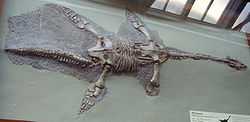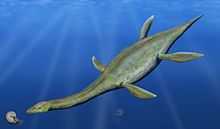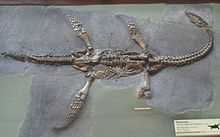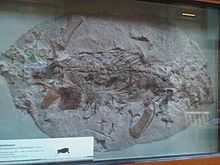Thalassiodracon
| Thalassiodracon Temporal range: Late Triassic-Early Jurassic | |
|---|---|
 | |
| Thalassiodracon hawkinsi found in the Lower Lias strata, Street, Somerset, England. | |
| Scientific classification | |
| Kingdom: | Animalia |
| Phylum: | Chordata |
| Class: | Sauropsida |
| Superorder: | Sauropterygia |
| Order: | Plesiosauria |
| Suborder: | Pliosauroidea |
| Genus: | Thalassiodracon Storrs & Taylor 1996 |
| Binomial name | |
| Thalassiodracon hawkinsi (Owen, 1838) | |
Thalassiodracon (tha-LAS-ee-o-DRAY-kon, meaning "sea dragon") is an extinct genus of small pliosaur that lived in the Late Triassic (Rhaetian) to the Early Jurassic (Hettangian) of Europe. The animal is known from a number of complete skeletons (Holotype: BMNH 2018) found by the fossil collector Thomas Hawkins in Somerset, England. The type and only species, Thalassiodracon hawkinsi named to honour its discoverer, was originally placed in the genus Plesiosaurus.
Description

life restoration of Thalassiodracon hawkinsi
This marine reptile measured 1.5–2 m. (5-6.5 ft) had a long neck but the skull was proportionally larger than Plesiosaurus, being 1/10 of the total body length.
Classification

Thalassiodracon hawkinsi skeleton, Natural History Museum in London

Fragmentary specimen
The following cladogram follows an analysis by Ketchum & Benson, 2011.[1]
See also
References
- ↑ Hilary F. Ketchum and Roger B. J. Benson (2011). "A new pliosaurid (Sauropterygia, Plesiosauria) from the Oxford Clay Formation (Middle Jurassic, Callovian) of England: evidence for a gracile, longirostrine grade of Early-Middle Jurassic pliosaurids". Special Papers in Palaeontology 86: 109–129. doi:10.1111/j.1475-4983.2011.01083.x.
See also
- List of plesiosaurs
| ||||||||||||||||||||||||||||||||||||||||||||||||||||||||||||||||||||||||||||||||||||||||||||||||||||||||||||||||||||||||||||||||||||||